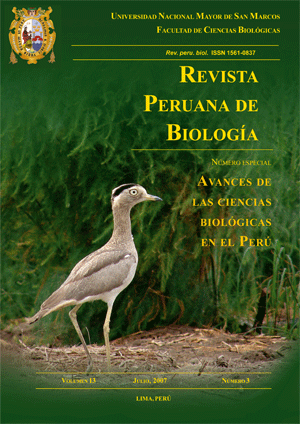Preliminary study of the Peruvian Amazon ichthyoplankton with emphasis on the Pimelodidae family
DOI:
https://doi.org/10.15381/rpb.v13i3.2354Keywords:
ichthyoplankton, Pimelodidae, Peruvian Amazon, migratory catfishes, Madre de DiosAbstract
This paper is a report of ichthyoplankton community and the description of fish larvae from the beginning of River Madre de Dios, in special on the family Pimelodidae. The collections were carried out between November and December of 2004, utilizing a ichthyoplankton net (300 microns of mesh), in 8 transects that covered an approximate section of 2 km upstream and downstream of the Puerto Maldonado city. A total of 83750 larvae were examined, the highest abundance was displayed by Characiformes (81%), followed by Siluriformes (18%). In the Pimelodidae family, 12 commercial species of consumption, emphasizing Pseudoplatystoma tigrinum, P. fasciatum y Sorubim lima. The main orders in ichthyoplankton follow a pattern of relative abundance similar to the adult state. The presence of larvae of great catfishes migratory (Pimelodidae family) in the zone of sampling suggests this region of the River Madre de Dios represents an area for reproduction, and therefore important for the conservation of these species.Downloads
Downloads
Published
Issue
Section
License
Copyright (c) 2006 María Rojas, Robinson Olivera, Roberto Quispe, Hernán Ortega

This work is licensed under a Creative Commons Attribution-NonCommercial-ShareAlike 4.0 International License.
AUTHORS RETAIN THEIR RIGHTS:
a. Authors retain their trade mark rights and patent, and also on any process or procedure described in the article.
b. Authors retain their right to share, copy, distribute, perform and publicly communicate their article (eg, to place their article in an institutional repository or publish it in a book), with an acknowledgment of its initial publication in the Revista Peruana de Biologia.
c. Authors retain theirs right to make a subsequent publication of their work, to use the article or any part thereof (eg a compilation of his papers, lecture notes, thesis, or a book), always indicating its initial publication in the Revista Peruana de Biologia (the originator of the work, journal, volume, number and date).






